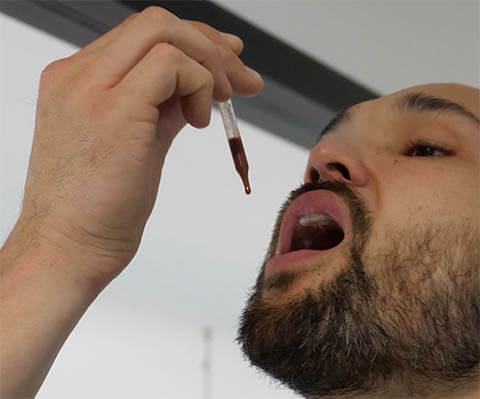Testosterone is a major sex hormone found in both men and women. It regulates sperm production, controls sex drive, increases energy, and promotes muscle mass. It also has effects on human behavior such as competitiveness and aggression.

As a person gets older, his levels of testosterone gradually decrease. This can cause changes in physiological functions, such as low libido. While low testosterone levels may cause concern, it is a natural part of aging.
An increase in testosterone production starts at puberty and begins to fall after the age of 30 or so.
Normal levels of testosterone
There are wide variations in the “healthy” or “normal” blood levels of testosterone. This depends on factors such as protein status, thyroid function, etc.
Recent guidelines released by the American Urological Association shows that the normal testosterone level for a man should be at least 300ng/dL. Low testosterone is diagnosed when the testosterone level falls below 300 ng/dL.
For females 19 years and up, normal levels of a testosterone range from 8 – 60 ng/dL according to the Mayo Clinic.
Testosterone reaches its peak levels at age 18 – 19 before it declines gradually throughout the remainder of adulthood.
The testosterone physiology
Testosterone is the major male androgen. This is indisputable. However, it is only one of many.
 The production of androgen requires a chain of complex events. Androgen production starts in the brain. Here, the hypothalamus produces the hormone – gonadotropin-releasing hormone. This hormone may also be called luteinizing hormone-releasing hormone. To simplify, hormones are chemical substances that are produced in a particular part of the body, and then perform their functions in another part.
The production of androgen requires a chain of complex events. Androgen production starts in the brain. Here, the hypothalamus produces the hormone – gonadotropin-releasing hormone. This hormone may also be called luteinizing hormone-releasing hormone. To simplify, hormones are chemical substances that are produced in a particular part of the body, and then perform their functions in another part.
Gonadotropin-releasing hormone is a hormone in the true sense of the word, but it doesn’t travel long distances; its action is in the brain, the pituitary gland specifically. The pituitary gland on its part secretes the follicle-stimulating hormone, and luteinizing hormone.
Both hormones are well-known for their actions on the ovaries of females, but they are equally important in men since they affect testicular function. Luteinizing hormone triggers the production of testosterone, while follicle-stimulating hormone, acting alongside testosterone, stimulates the production of sperm cells.
The Leydig cells in the testicles are responsible for testosterone production. Cholesterol serves as the starting point. Cholesterol is well-known for its deleterious effects on heart health, but equally plays a very vital role as the building block of both male and female sex hormones. After a series of steps, cholesterol converts to androstenedione.
Testosterone affects male metabolism and male anatomy in many ways. It is responsible for the increased muscle mass, the deep voice, and the strong bones that are characteristic of males. It stimulates erythrocytosis (red blood cell production) by the bone marrow. Testosterone also contributes to male behavior – the aggressiveness, sex drive, sexual performance, and normal erections. The stimulation of genital growth during puberty is caused by testosterone. It is also responsible for the production of sperm all through adult life. Testosterone also has a great influence on cholesterol metabolism, even though scientists aren't sure about the effects that this has on human health.
Testosterone acts directly on the body’s tissues, but some of its effects only occur after they have converted to dihydrotestosterone, another form of androgen. Dihydrotestosterone acts on the skin, giving rise to acne in some cases. It also acts on the hair follicles, causing the growth of hair on the chest, but often removing it from the scalp. Dihydrotestosterone is also responsible for the growth of prostate cells, contributing to prostate cancer and benign prostatic hyperplasia in elderly men.
The testicles produce at least 95% of testosterone in the male. Testicular production of testosterone is controlled by luteinizing hormone. The other 5% is produced by the adrenal glands. Testosterone is also produced in the adrenal glands of women. In both genders, neither FSH nor LH contributes to the production of adrenal hormone production. Dehydroepiandrosterone is a major precursor of testosterone in both genders.
During its final phase of metabolism, testosterone is converted to estradiol, an important female hormone. The conversion occurs in fat cells, which explains why obese women and men have a higher level of estrogen than lean women and men.
What impact does age have on testosterone levels?
Testosterone production starts early in the males. In most cases, it begins in the 7th week of embryonic development. It remains at high levels during fetal development but falls just before delivery. Male babies experience a blip in production of testosterone between the third and sixth month of life, but by 12 months of age, their levels fall back. Between 6 and 8 years of age, the production of adrenal androgen shoots, stimulating growth spurt but no sexual development.
Testosterone production receives a boost at puberty due to LH and GnRH surge. The increased testosterone stimulates the growth of muscles and bones, red blood cell production, growth of body and facial hair, enlargement of the voice box, the revival of reproductive and sexual function. In young men, testosterone production attains its peak at 17 years of age, with the levels remaining consistently high for 2 – 3 decades. On average, young men with no health issues can produce 6mg of testosterone daily.
Some men have high levels of testosterone throughout life. However, a decline in testosterone levels begins at about age 40 in some men. The decline in men is gradual compared to the precipitous drop that occurs in menopausal women. By 70 years of age, testosterone production will fall to less than 30% of normal. But that notwithstanding, the levels of testosterone remain within the normal range in at least 75% of elderly men. This explains why men in their 80s can still father children. It is worth noting that no study has established a link between low testosterone levels and the risk of erectile dysfunction.
The answer to the question “what impact does age have on testosterone level” is complex. There is no established single normal level for testosterone. Most healthy men exhibit a wide range – somewhere between 270 & 1070 ng/dL. But like other biological functions, production of testosterone waxes & wanes over a cycle of 24 hours. Production is high at 8 am and falls to its lowest at 9 pm.
Aging introduces a final complexity to the subject. Testosterone occurs in two forms in the blood – it may be bound to proteins or maybe free and move around unbound. Testosterone binds to globulin tightly. But weakly to albumin. Free testosterone and albumin-bound testosterone are biologically active. The androgen-binding protein increases with age, so even at old age, a man may have normal levels of testosterone, but low levels of biologically-active testosterone.
It may not be necessary for a man to understand the entire physiology of testosterone, but it is worth noting that these complexities contribute to the flaws in most researches on testosterone replacement therapy. If a man wishes to know where he stands, he should get his bioavailable or free testosterone levels measured. Measurement is best done early in the morning.
A 2005 study by Barrett-Conor shows testosterone levels as measured in healthy men between 40 – 79 years of age. This is illustrated in the table below:
|
Age |
Total testosterone |
Free testosterone |
Bioavailable testosterone |
|
40–49 |
252–916 |
5.3–26.3 |
101–499 |
|
50–59 |
215–878 |
4.2–22.2 |
80–420 |
|
60–69 |
196–859 |
3.7–18.9 |
69–356 |
|
70–79 |
156–819 |
2.2–14.7 |
41–279 |
|
Source: "Male Testosterone: What is normal?," Barrett-Conor, Clinical Endocrinology 2005;62(3):263–64. |
|||
Testosterone study references
- Baillargeon J, et al. (2014). Trends in androgen prescribing in the United States, 2001-2011.
nlm.nih.gov/pmc/articles/PMC4100547 - Bawor M, et al (2015). Testosterone suppression in opioid users: A systematic review and meta-analysis. DOI:
1016/j.drugalcdep.2015.01.038 - Beking T, et al. (2018). Prenatal and pubertal testosterone affect brain lateralization. DOI:
1016/j.psyneuen.2017.10.027 - Evaluation and management of testosterone deficiency. (2018).
org/guidelines/testosterone-deficiency-(2018) - Health encyclopedia. Total testosterone. (n.d.).
rochester.edu/encyclopedia/content.aspx?ContentTypeID=167&ContentID=testosterone_total - McBride J, et al. (2016). Testosterone deficiency in the aging male. DOI:
1177/1756287215612961 - Matei V, et al. (2014). Prenatal sex hormone exposure and risk of Alzheimer's disease: A pilot stud using the 2D: 4D digit length ratio.
lww.com/cogbehavneurol/Abstract/2014/06000/Prenatal_Sex_Hormone_Exposure_and_Risk_of.7.aspx - Mayo Clinic Staff. (2016). Male hypogonadism.
org/diseases-conditions/male-hypogonadism/diagnosis-treatment/drc-20354886 - Ostatnikova D, et al. (2015). On the effects of testosterone on brain behavioral functions. DOI:
3389/fnins.2015.00012


